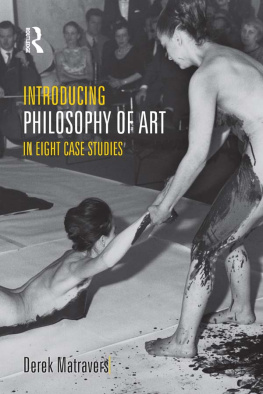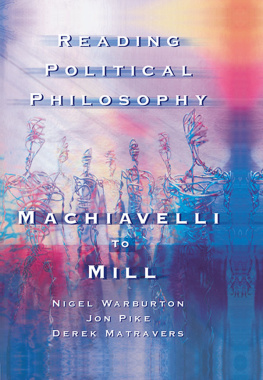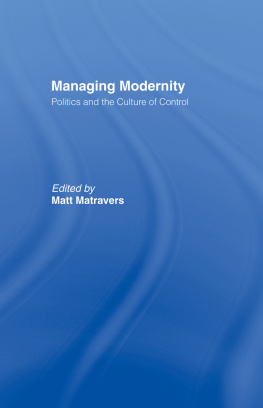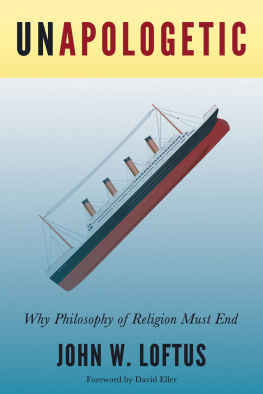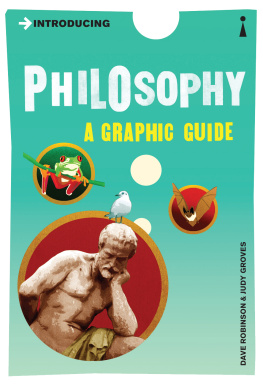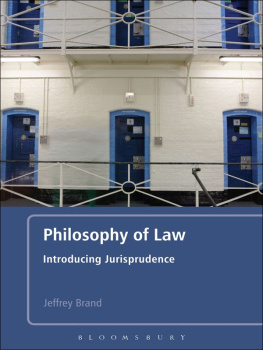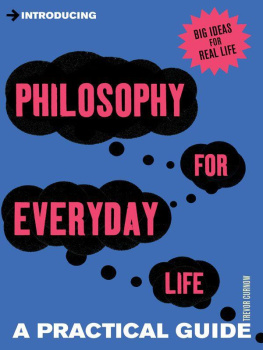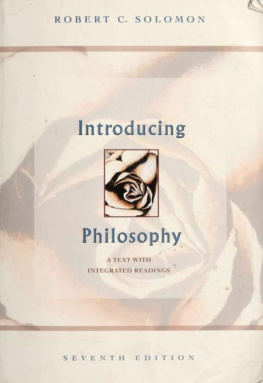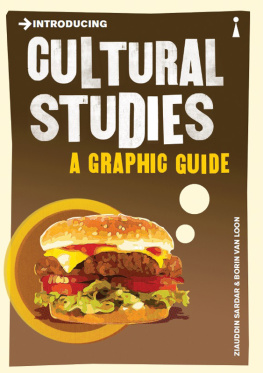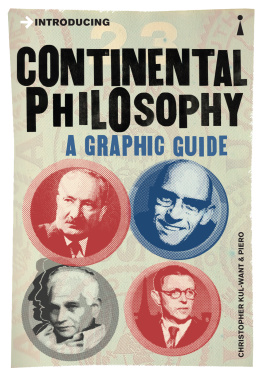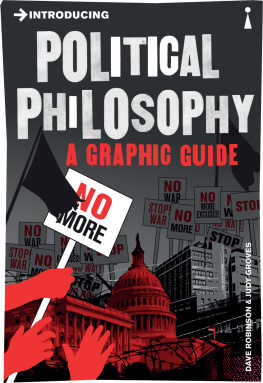Matravers - Introducing philosophy of art in eight case studies
Here you can read online Matravers - Introducing philosophy of art in eight case studies full text of the book (entire story) in english for free. Download pdf and epub, get meaning, cover and reviews about this ebook. City: London;New York, year: 2014, publisher: Taylor & Francis (CAM);Routledge, genre: Art. Description of the work, (preface) as well as reviews are available. Best literature library LitArk.com created for fans of good reading and offers a wide selection of genres:
Romance novel
Science fiction
Adventure
Detective
Science
History
Home and family
Prose
Art
Politics
Computer
Non-fiction
Religion
Business
Children
Humor
Choose a favorite category and find really read worthwhile books. Enjoy immersion in the world of imagination, feel the emotions of the characters or learn something new for yourself, make an fascinating discovery.
Introducing philosophy of art in eight case studies: summary, description and annotation
We offer to read an annotation, description, summary or preface (depends on what the author of the book "Introducing philosophy of art in eight case studies" wrote himself). If you haven't found the necessary information about the book — write in the comments, we will try to find it.
Matravers: author's other books
Who wrote Introducing philosophy of art in eight case studies? Find out the surname, the name of the author of the book and a list of all author's works by series.
Introducing philosophy of art in eight case studies — read online for free the complete book (whole text) full work
Below is the text of the book, divided by pages. System saving the place of the last page read, allows you to conveniently read the book "Introducing philosophy of art in eight case studies" online for free, without having to search again every time where you left off. Put a bookmark, and you can go to the page where you finished reading at any time.
Font size:
Interval:
Bookmark:
INTRODUCING PHILOSOPHY OF ART
INTRODUCING PHILOSOPHY OF ART
IN EIGHT CASE STUDIES
Derek Matravers

For Ed Winters and Vanessa Perry
First published 2013 by Acumen
Published 2014 by Routledge
2 Park Square, Milton Park, Abingdon, Oxon OX14 4RN
711 Third Avenue, New York, NY 10017, USA
Routledge is an imprint of the Taylor & Francis Group,
an informa business
Derek Matravers, 2013
This book is copyright under the Berne Convention.
No reproduction without permission.
All rights reserved. No part of this book may be reprinted or reproduced or utilised in any form or by any electronic, mechanical, or other means, now known or hereafter invented, including photocopying and recording, or in any information storage or retrieval system, without permission in writing from the publishers.
Notices
Practitioners and researchers must always rely on their own experience and knowledge in evaluating and using any information, methods, compounds, or experiments described herein. In using such information or methods they should be mindful of their own safety and the safety of others, including parties for whom they have a professional responsibility.
To the fullest extent of the law, neither the Publisher nor the authors, contributors, or editors, assume any liability for any injury and/or damage to persons or property as a matter of products liability, negligence or otherwise, or from any use or operation of any methods, products, instructions, or ideas contained in the material herein.
ISBN: 978-1-84465-536-6 (hardcover)
ISBN: 978-1-84465-537-3 (paperback)
British Library Cataloguing-in-Publication Data
A catalogue record for this book is available from the British Library.
CONTENTS
Yves Kleins Anthropometries
Lucian Freuds Hotel Bedroom
Mark Rothkos Black on Maroon
Gerhard Richters Dead 2
Louise Bourgeoiss Maman
Francis Bacons Three Studies for Figures at the Base of a Crucifixion
Edward Hoppers Nighthawks
Balthuss Thrse Dreaming
I am grateful to Steven Gerrard at Acumen who first suggested this project, and has been a source of support throughout. The book has been much improved by suggestions from two anonymous readers, to whom I owe many thanks. There are several places where the argument was either improved or corrected outright. I am grateful to Gillian Rose for introducing me to the work of Nicolas Bourriard, to the late Charles Harrison for discussions of Rothko, to Jason Gaiger for discussions about the contemporary arts, and to Jon Phelan for discussions around . It is a pleasure to record my thanks to Jane Collins and not only for providing me with the glorious room in which most of this was written. It is particularly important, given that my views on the matters that follow are not always widely shared, that I take responsibility for all errors, particularly any about which people have tried and failed to change my mind. Finally, it is a great pleasure to dedicate this book to Edward Winters and Vanessa Perry, in whose company I have spent many happy hours looking at pictures, listening to music and generally hanging out.
Derek Matravers
As philosophy is really just a matter of thinking deeply about things, and as art is one of the most fascinating things to think about, it is no surprise philosophers have things to say about art. In the past century or so, the list of things to think about in the arts seems to have multiplied. Largely unmodified objects such as urinals and beds appear to be art, as well as thoughts, lights that switch on and off, and walks in the countryside. This book aims to introduce eight debates in the philosophy of art through discussion of eight particular examples. Before launching into the first of these, I want to try to clarify what I am hoping to do in this book. First, I shall say something about the ambitions of the book. Second, I shall say something about the philosophical approach I shall be taking. Finally, I shall say something to distinguish the philosophy of art from other enquires that flourish in the same hedgerow.
What, then, of the books scope? First, it does not attempt to cover all the arts. The focus will be on the visual arts rather than on music, or literature, or even architecture (if architecture is an art). There are complicated reasons for taking this narrow approach, some of which will be explored in encounter. However, we will not encounter all of them. Those whose appetite is still undimmed can do their own research among the suggestions for further reading.
Our topic, the philosophy of art, is sometimes bracketed with another topic, aesthetics, to which it stands in a complicated relationship. The term aesthetics is derived from the Greek word aisthanomai, which means I perceive. That is, aesthetics originally encompassed a whole range of issues to do with perception and consciousness. In the eighteenth century, the German philosopher Alexander Baumgarten narrowed the term and used it to refer to a particular kind of perception: the perception of beauty. This usage quickly took hold and survives to this day. It may appear obvious that the discussion of art will lead quickly to the discussion of beauty; after all, plausibly, being beautiful is the aim and purpose of works of art. Even if this were true, the discussion of beauty would have to cover much else besides art. There are plenty of things that are beautiful that are not art, such as roses, sunsets and other natural objects. Indeed, the character of the link between art and beauty has been the subject of much fraught discussion. We shall encounter this discussion throughout the book with questions as to what it is to be a work of art (which I consider in ). In each case, the link between art and beauty is contentious; indeed, it is frequently denied that there is a link at all. As I do not want to stack the deck in favour of any particular view, I shall follow tradition and use aesthetics as the broad term for discussions of beauty, and the philosophy of art as the broad term to cover problems that arise from our thinking about the arts. By distinguishing the terms in this manner, I can use them without presupposing the nature of the relation between art and beauty.
Philosophers do not have a monopoly in thinking about these issues. Those who think about art constitute a broad church, encompassing philosophers of art, art historians, art theorists, art critics and artists themselves. Someone picking up this book might be seduced into thinking that the approach taken herein is the only possible approach. This is far from the truth as the different disciplines approach thinking about art in different ways. What follows is a sketchy map of the territory, so that I can locate this book somewhere on that map.
It may surprise those who are new to the subject that philosophy is a fairly Balkanized discipline. One tradition in philosophy stems from the eighteenth-century empiricists, and received a boost in the twentieth century from philosophers who were much influenced by logic and analysis such as Bertrand Russell and G. E. Moore. Philosophy in this tradition is referred to as analytic or Anglo-American philosophy (I shall use the latter label). English-speaking philosophy departments, if they do philosophy of art at all, tend to follow the Anglo-American approach and this book is in the Anglo-American tradition. The label for philosophy that is done in the other tradition is continental philosophy. This embraces traditions in German, French and other philosophies that may not have much in common with each other. As I write, it is the continental tradition that tends to dominate outside philosophy departments, particularly in the art schools. The nature of the distinction between the Anglo-American tradition and the continental tradition is much disputed, so any attempt to characterize it will be tendentious. I shall, rather pusillanimously, remain silent on the issue.
Next pageFont size:
Interval:
Bookmark:
Similar books «Introducing philosophy of art in eight case studies»
Look at similar books to Introducing philosophy of art in eight case studies. We have selected literature similar in name and meaning in the hope of providing readers with more options to find new, interesting, not yet read works.
Discussion, reviews of the book Introducing philosophy of art in eight case studies and just readers' own opinions. Leave your comments, write what you think about the work, its meaning or the main characters. Specify what exactly you liked and what you didn't like, and why you think so.

